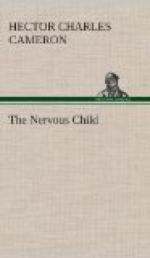The treatment of all these symptoms calls for much insight. The child’s confidence must be completely secured, and he must be encouraged to tell of all his sensations and of the reasons which prompt his actions. The nervous child has a horror of appearing unlike other children, and will suffer in silence. If his troubles are brought into the light of day with kindness and sympathy they will melt before his eyes. Even night-terrors are, as a rule, determined by the suppressed fears of his waking hours. If they are provoked by his experiences at school, by the fear of punishment or by dismay at a task that has proved beyond his powers, he should be taken away from school for the time being. Night-terrors are said to be aggravated by nasal obstruction due to adenoid vegetations. Clothing at night should be light and porous, and particular attention should be paid to the need for free ventilation.
We have spoken in an earlier chapter of the trouble sometimes experienced in inducing a nervous child to go to sleep. In older children insomnia is common enough. Even when sleep comes it may be light and broken, as though the child slept just below the surface of consciousness and did not descend into the depths of sound and tranquil slumber. We have often noticed how different is the estimate of the patient from that of the nurse as to the number of hours of sleep during the night. The sick man maintains that he has hardly slept at all, whilst the nurse, drawing us aside, whispers in our ear that he has slept most of the night. In estimating sleep we have to consider not only its duration, but also its depth, and the patient who denies that he has slept at all has lain perhaps half the night with an active restless brain betwixt sleep and wakefulness. Often enough when he comes to consider in the morning the problems that vexed his soul at midnight, he is quite unable to recall their nature, and recognises them as the airy stuff that dreams are made of. Although in a sense asleep he may have retained a half-consciousness of his surroundings and a sense of despair at the continued absence of a sounder sleep.
With nervous children we are apt to find sleep which is of little depth and which constantly shows evidence of a too-active brain. The body is tossed to and fro, words are muttered, and the respiration is hurried and with a change in rhythm, because there is no depth of anaesthesia. The body still responds to the impulses of the too-active brain. From the nature of his dream—as shown by chance words overheard—we may sometimes gather hints to help us to find where the elements of unrest in his daily life lie. Sleep-walking is only a further stage in this same disorder of sleep, in which the dream has become so vivid that it is translated into motor action.




